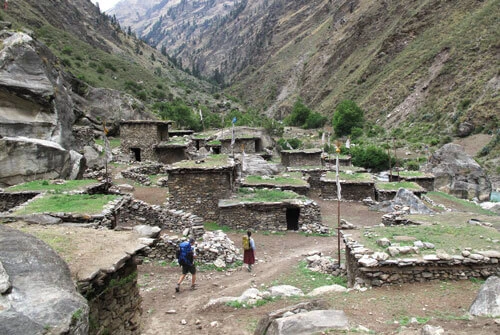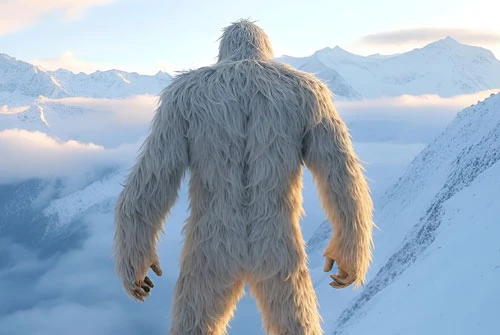Originally Trekking came from 'TREKKEN' an Afrikaans word meaning a long journey by ox wagon. It is said that this Afrikaans word gradually evolved into Trekking in the course of time. Trekking in the Himalayas signifies walking or hiking up and downhill. Thus, trekking is a walking trip on mountain trails from just a few days to a month or more, in the same style as exploratory or mountaineering expeditions. Trekking can be a leisurely activity: you carry only what you might want during the day - Cameras, Binoculars, Sweaters, etc while porters, mules, or yaks carry all equipment and personal belongings. Or you may opt to do it the hard way, personally carrying all your gear on your back.
About Trekking in the Himalayas
Table of Contents
What Actually is Trekking?
Trekking is not a climbing trip. Though some trekking venture to extreme altitudes and near glaciers, or even cross them, most trekking do not allow the achievement of any Himalayan mountaineering ambitions. As a rule, alpine techniques are not used in traditional trekking and all trails are easily traversed without the aid of ropes or any mountaineering skill.
It spends most of its time in the middle hills between 800m and 4,500m. In this region, trekking is always on well-developed trails through villages and across the mountain passes. Trekking does not necessarily imply a true wilderness experience. Although isolation is traditionally a crucial element for those in the outdoors pursuit, it is often impossible to get completely away from people, except for short times or at extremely high elevations. Even in these higher elevations, small settlements of stone houses and yak pastures dot every possible flat space.
What You Need to Know About Trekking!
Much of the Himalayas is still largely without roads. Access to its interior- its villages and valleys, its mountains, deserts, and hills- is by ancient foot trails, and trade and pilgrimage routes that interlace in an intricate pattern across the land. It is difficult though for most Westerners to comprehend this aspect of life until they actually set foot on these hills, as their preconception of a roadless area is strongly influenced by the places they backpack or hike at home- true wilderness, usually protected as a national park or forest.
Much of the fascination of trekking will be derived from the opportunity to observe life in these picturesque villages inhabited by perhaps the world’s friendliest people, their traditional hospitality, fascinating cultures, and traditions seem to exemplify many of the attributes modern technical life have lost in rush for development and progress. Indeed, the real adventure is new insights, the awe found in nature encounters with new cultures, and the excitement of personal discovery.
Trekking in the Himalayas is a special kind of mountain holiday unlike any other in the world that gives you the chance to experience the true Freedom of the Hills!
Why Trek?
“Trekking, I consider as exciting as big mountain climbing but is more satisfying in the sense that there is peace and more involvement with Nature, more than in other mountain activity.”
–Sir Edmund Hillary
Trekking in the Himalayas opens up new horizons of awareness, blending physical challenge with mental relaxation and a spiritual elation inspired by splendid scenery and heartwarming human encounters. It’s an experience that will expand your appreciation of the world and give you a new perspective on your own life.
It provides you with a unique learning experience: by taking you away from a familiar environment, it gives people a chance to develop areas of their personality that may otherwise have been left dormant – a perfect setting to sharpen your leadership skills. Trekking involves participation: the more you put in, the more fun you’ll have. You’ll also make new friends, often for life, not to mention having some great stories to tell when you get home.
Trekking or Hiking is a perfect activity and a natural form of exercise for a healthy lifestyle too. It helps reduce the risk of heart disease, high blood pressure, arthritis, strokes, diabetes, bowel cancer, anxiety, stress, etc. Trekking helps you stay healthy, kick start a new regime, keep your weight under control, and gain a sense of achievement. It also improves your stamina, life expectancy, and most importantly your overall sense of well-being.
Fitness and Preparation
The most common misconception about walking, and particularly trekking holidays, is that you must be young and super-fit to go on them- nothing could be further from the truth. Most of our holidays are about an enjoyable walking experience for those who, whatever their age, are in a reasonable state of health and fitness. It is more about enjoying a good hill walk that allows you to take your time, set your own pace, and enjoy the experience. It goes without saying, of course, that the fitter you are the more you will enjoy it, and you will have enough energy for extra activities.
Let us also remind you, that no treks in the Himalayas are easy, with the general terrain invariably involving long stretches of steep up-and-down. There is little flat terrain. The trails are well-marked and generally contoured, but in places, you may have to put up with the ceaseless onslaught of steps. This can prove physically tiring, especially as the altitude increases, and can put a lot of stress on your knees. The time you put into physical training before you come, however, will definitely be rewarded.
The best physical preparation is to walk up and down, as often as possible, on hills (and on steps, for 30-40 minutes) preferably with a pack in variable weather conditions. Start at least three months prior to the trek to build up stamina and endurance. Don’t forget that you will be exercising constantly for a number of days. Wear the boots you plan to wear on the trek. Supplement this activity with running, cycling, or swimming, for additional aerobic conditioning.
While it is good to have aerobic fitness, walking on variable terrain is still the key element. If you have a busy life, with little access to hiking on weekends, or if you have no hills to train on, endurance training should be your primary focus. You should train with exercise machines (such as ‘Stairmasters’) and take stairs whenever possible in preference to a lift or elevator.




